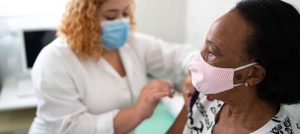Ending racism in healthcare often begins with medical education - and is the target of a new national project
Inequities can be found in every facet of the industry, but targeting medical students and residents can help stem the tide.

(Photo by FG Trade/Getty Images)
To say that race has been a much-debated topic during the pandemic would be an understatement. Racial tensions were hitting a boiling point in the U.S. even before the world shut down due to COVID-19, and now the pandemic has highlighted racial disparities that exist in many facets of American life, including in healthcare.
Bias and inequity can be found in many areas of the industry. One that has been overlooked is medical education, which can oftentimes result in clinical trainees internalizing implicit bias. But a new initiative is looking to change that.
Project IMPACT is a collaboration between clinical decision support system company VisualDx, the Skin of Color Society and the New England Journal of Medicine Group. Project IMPACT – Improving Medicine's Power to Address Care and Treatment – looks to bridge gaps in knowledge and improve outcomes for people of color.
Initially focusing on the field of dermatology, two goals are to raise awareness and adoption of educational and clinical resources, with an eye toward bolstering clinicians' ability to accurately diagnose disease in black and brown skin, and to improve health equity.
Practicing dermatologist Dr. Nada Elbuluk, VisualDx's director of clinical impact, said bias and racism in healthcare account for why there are often different outcomes for people of different backgrounds. One of the ways racism comes into play is through implicit bias, and there are different ways in which this can manifest itself. Sometimes it may be viewpoints or beliefs that clinicians don't realize they're acting on when treating people of different backgrounds.
"There's also bias within medical education," said Elbuluk. "People can be trained and educated on diseases in a way that is not representative of all backgrounds – and that can also lead to various kinds of cognitive biases."
In dermatology in particular, patients with darker skin may be diagnosed incorrectly, or receive a delayed diagnosis if the evaluating clinician wasn't properly educated on how diseases manifest in darker skin. And that's just one way in which bias can lead to health disparities.
Patients can also have increased disease burden and decreased quality of life – issues that can exacerbate existing disparities because of the lack of representative, equitable education for providers.
THE SCOPE OF THE PROBLEM
To be sure, inequity exists in virtually every facet of the healthcare system. Take a December 2020 study published in JAMA Network Open, which found significant inequities in the field of telehealth.
The researchers examined data for nearly 150,000 patients of a large, academic medical system. Of the patients who had visits previously scheduled, a little more than half, roughly 81,000 (54%), conducted their visits via telehealth, the data showed. And within that segment, less than half, nearly 36,000, (46%) had visits conducted via video.
When these visits were broken down by the patients' characteristics, some clear inequities were found. Overall, patients who were older than 55 were 25% less likely than the average patient to successfully participate in a telehealth visit, with people older than 75 being 33% less likely.
People who identified as Asian were 31% less likely to conduct a telehealth visit, and those who did not speak English were 16% less likely. Using Medicaid for insurance also made patients less likely to successfully conduct a virtual visit by 7%.
Moreover, women were 8% less likely to participate in a video visit than men, Latinx patients were 10% less likely than white patients, and Black patients 35% less likely than white people.
And then there's August 2020 research that found significant disparities among racial and ethnic groups after reviewing nearly 49,000 COVID-19 hospitalizations over a two-month period.
When compared to the populations of each state, people identified as being African American or Black were hospitalized at higher rates than those who were white in all 12 states reporting data, with Ohio (32% hospitalizations and 13% population), Minnesota (24.9% hospitalizations and 6.8% population) and Indiana (28.1% hospitalizations and 9.8% population) having the largest disparities.
Hispanics were hospitalized at higher rates than those who were white in 10 of the 11 states reporting this data, with Virginia (36.2% hospitalizations and 9.6% population), Utah (35.3% hospitalizations and 14.2% population) and Rhode Island (33% hospitalizations and 15.9% population) showing the biggest disparities.
THE APPROACH
Project IMPACT was created in part because one of the best means of eliminating racial and implicit bias in medicine is targeting the source: medical education, where the bedrock of a clinician's professional philosophy is often set.
"I think this problem has been overlooked," Elbuluk said. "For so long, people didn't realize that medical education was not diverse enough in its representation of people of different backgrounds. I think it went on like that for so long that people just became used to that as the baseline.
"It's being highlighted much more significantly now, which is important and much needed. Hopefully institutions are now reevaluating their curricula and educational resources to make sure that they are minimizing bias and that they are representative of the diverse spectrum of our patients and of our world."
Ideally, the problem would have been addressed long ago. The reason it has been pulled into greater focus, said Elbuluk, is because many of the systemic injustices that existed in the U.S. and now coming to light, with an increased visibility of the racism that can affect Blacks, Hispanics, Asians and others on a national level. Sectors of society, including the healthcare industry, are looking inward and what they can achieve.
"Healthcare is just one sector of society dealing with systemic racism," said Elbuluk. "Now that it's at the forefront, people in healthcare are reevaluating where there are mistakes and how to correct things to improve health equity."
Enter Project IMPACT, which was birthed during the grips of the pandemic in 2020. VisualDx, SOCS and NEJM Group held a four-part educational webinar series last year that addressed issues such as structural racism, bias, healthcare disparities and different diseases affecting communities of color, including COVID-19. More than 32,000 people from about 100 countries joined the webinars.
What the series revealed was a shared mindset and philosophy among the three organizations. When VisualDx launched the project it wanted to do so with like-minded collaborators, so joining forces felt like a natural and organic step.
"The big-picture goal is to improve health equity," Elbuluk said. "That's a big goal, so there are lots of granular ways in which we're trying to achieve that. Currently we're very focused on improving gaps in educational resources at the medical school and resident levels, as well as the (continuing medical education) level in relation to patients of color."
To change the narrative, the project is pulling from a large and diverse collection of medical images, putting them in the hands of more future and current providers to give people a more representative, diverse educational resource from which to learn. Elbuluk expects this will have downstream effects on improving disparities and outcomes.
The project is also working on creating educational tools, like teaching sets with imaging, that people can use and share within their own institutions and networks to help educate others. The idea is to create problem sets, questions and other methods to engage people and educate themselves.
On top of all that is a library of resources on Project IMPACT's web page, featuring articles related to racial bias and health disparities as well as textbooks on ethnic skin, skin of color and other topics within dermatology, such as hair and nail issues across different skin types.
"There are also disparities in other fields of medicine – in obstetrics/gynecology, cardiology, the list goes on – and we want to help narrow the gap educationally in those fields as well using whatever methods we can to improve health equity across medicine," Elbuluk said. "That's our long-term goal, but we're starting right now by really focusing on disparities related to dermatology."
She hopes in the coming months and years to have more collaborators and sponsors for Project IMPACT, and is focused on continuing to strategize ways to improve health equity through medical education.
"To that end, we'd like to get VisualDx into as many places as possible both nationally and internationally," said Elbuluk. "We recognize that in some parts of the world, cost and access may be an issue, so we're looking for ways we can raise funds to overcome those challenges in order to support global communities as well."
The project hopes to activate its blog soon, which will highlight skin of color conditions as well as leaders in medicine who are making an impact in improving health disparities. Project IMPACT is also promoting resources like a patient-facing website called Skinsight and a mobile app called Aysa, both free and publicly available, that will attempt to engage and educate patients directly.
"We're really working on improving education at all levels," Elbuluk said, "from the patient side all the way to the provider side."
How COVID-19 has transformed public policy and population health efforts
Special Report: Telehealth, mental health and racial inequality issues have put a spotlight on how to address the needs of underserved populations.
Twitter: @JELagasse
Email the writer: jeff.lagasse@himssmedia.com












































